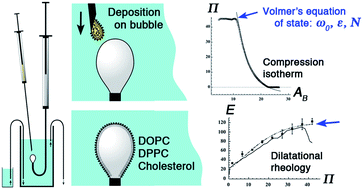A study of insoluble monolayers by deposition at a bubble interface
Abstract
We propose an experimental approach, alternative to Langmuir trough, pendant or sessile drop experiments, to study insoluble monolayers at the air–water interface. The method is based on the direct deposition of an insoluble surfactant at the interface of an air bubble, measuring the surface tension according to the classical axisymmetric drop shape analysis (ADSA) technique. This bubble configuration, in contrast to the classical ones for studying Langmuir monolayers have several remarkable advantages like the easy control of the surrounding bulk composition (opening new potential research applications), the fast experimental time for a monolayer to be ready (<20 min), the small bulk volume (10 mL), and mostly the simple way to carry out dilatational rheology. The experiment consists of performing compression of an insoluble monolayer recording the Π–AB curve (Π is the interfacial pressure and AB the bubble area) and obtaining dilatational rheology over the compression range establishing the E–Π curve (with E is the elastic modulus). We showed that the experimental results can be satisfactorily fitted using the Volmer's equation of state including the two-dimensional compressibility factor ε, offering access to the excluded area per molecule ω0 and to the number N of molecules at the interface, without initially knowing the amount of deposited material. This proof of concept study was carried out on dioleoyl-sn-glycerophosphatidylcholine (DOPC), dipalmitoyl-sn-glycerophosphatidylcholine (DPPC), and cholesterol at 20 °C, systems chosen to show qualitative differences in their thermodynamic behavior upon monolayer compression. Likewise, dilatational rheology of these insoluble monolayers allows evidencing the compressibility of the DOPC monolayer in contrast to the DPPC monolayer, and finally, the compression domains where the interface loses the surfactant through a comparison of the dilatational elasticity with the Gibbs elasticity calculated from the compression curves. Finally, we propose an example of the new application offered by the possibility to exchange the fluid phase surrounding the bubble, herein to study mixed monolayers made with soluble/insoluble surfactants (Tween 80/Span 65).


 Please wait while we load your content...
Please wait while we load your content...